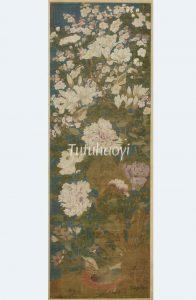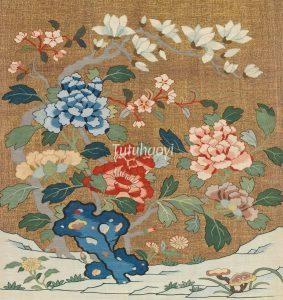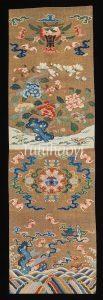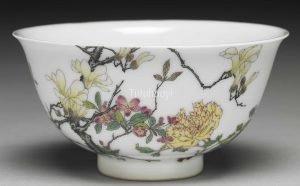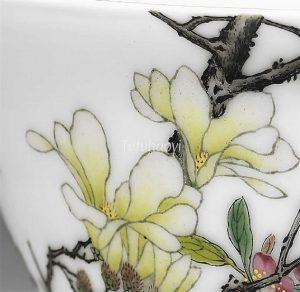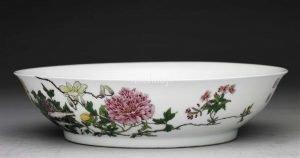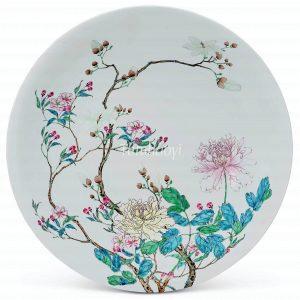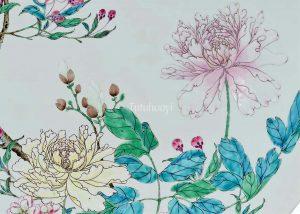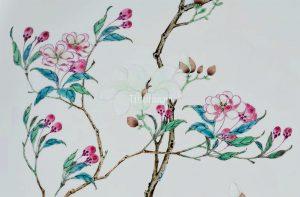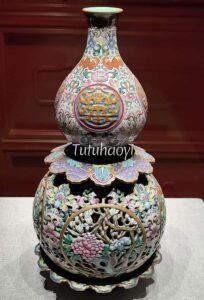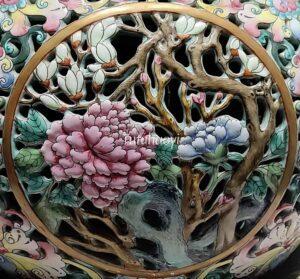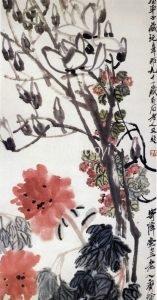May your jade palatial home be honoured and full of riches
玉堂富贵
© Tutuhaoyi.com owns the copyright of the description content for the images attached. Quoting all or part of the description content on this page is permitted ONLY IF ‘Tutuhaoyi.com’ is clearly acknowledged anywhere your quote is produced unless stated otherwise. (本页描述内容版权归Tutuhaoyi.com所有,转发或引用需注明 “Tutuhaoyi.com”, 侵权必究, 已注开源信息的条目除外。)
The character ‘yu 玉’ in ‘yulan hua 玉兰花’ for ‘magnolia’ is the same ‘yu 玉’ for ‘jade’. The word ‘tang 棠’ from ‘haitang hua 海棠花’ for ‘crabapple’ is homophonic with the word ‘tang 堂’ for ‘house’. The combination of the two characters ‘yutang 玉堂’ means ‘jade house’ with connotations of being grand and palatial.
The peony flower, known in Chinese as ‘mudan hua 牡丹花’, has a nickname of ‘fugui hua 富贵花’, literally, the ‘flower of wealth and prestige’.
Therefore, a composition of blooms of magnolia, crabapple, and peony can be used to convey the auspicious wish of ‘May your jade palatial home be honoured and full of riches!’
Related Pun Picture:
Fig 1: 玉堂富貴图, hanging scroll, ink and colour on paper, attributed to Xu Xi (徐熙 886–975), courtesy of the National Palace Museum, Taipei
Fig 2-3: chair strip made of tapestry-woven (kesi) silk and metallic thread, 18th century, courtesy of the Metropolitan Museum of Art, New York, Accession Number: 65.210.1
Fig 4: copper vase with enamelled decoration, Kangxi period (1662–1722), Qing dynasty, courtesy of the National Palace Museum, Taipei
Fig 5-7: porcelain bowl with enamelled decoration, Yongzheng period (1723–35), Qing dynasty, courtesy of the National Palace Museum, Taipei
Fig 8: porcelain dish with enamelled decoration, Yongzheng period (1723–35), Qing dynasty, courtesy of the National Palace Museum, Taipei
Fig 9-11: porcelain dish with overglaze enamelled decoration, Yongzheng period (1723–35), Qing dynasty, courtesy of Christie’s Auction House, New York, 2021
Fig 12: famille rose porcelain dish, Yongzheng period (1723–35), Qing dynasty, courtesy of the Museum of Far Eastern Antiquities, Stockholm, OM 1977-0138
Fig 13: famille rose porcelain snuff-bottle, Qianlong period (1736–95), Qing dynasty, courtesy of the Museum of Fine Arts, Boston
Fig 14: famille rose porcelain snuff-bottle, Qianlong period (1736–95), Qing dynasty, courtesy of the National Palace Museum, Taipei
Fig 15: pink ground famille rose moonflask, Qianlong period (1736–95), Qing dynasty, courtesy of the Christie’s Auction House, Hong Kong, 8 Oct 2020, Lot 334
Fig 16-17: famille rose porcelain vase, Qianlong period (1736–95), Qing dynasty, courtesy of the Metropolitan Museum of Art, New York, Accession Number: 14.40.89
Fig 18-19: famille rose porcelain vase, Qianlong period (1736–95), Qing dynasty, courtesy of the Palace Museum, Beijing, China, photography by Rachel Ma
Fig 20: 玉堂富贵图, hanging scroll, ink and colour on paper, by Qi Baishi (齐白石 1864–1957), 1936, courtesy of the National Art Museum of China
